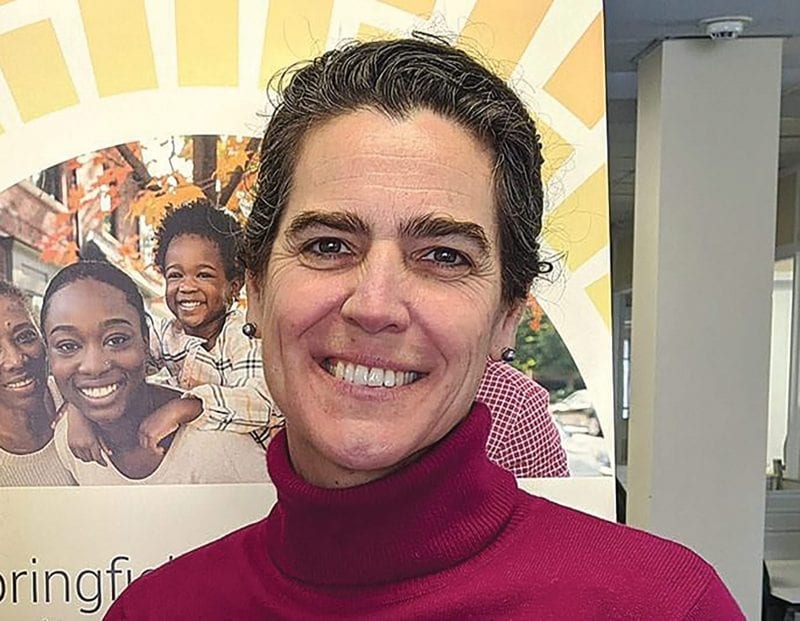Opioid Overdose Deaths Rise in Massachusetts, Nationwide
Hard Pill to Swallow
By Joseph Bednar

It’s been a tough year in the battle against opioid addiction, Jessica Collins said — but no one’s throwing in the towel.
“The prevention world did not stop throughout the pandemic,” said the executive director of the Public Health Institute of Western Massachusetts during a recent virtual forum on the opioid crisis hosted by U.S. Sen. Edward Markey. But the stresses caused by COVID-19 have certainly presented another layer of challenge.
“My colleagues in Berkshire, Franklin, Hampshire, and Hampden counties are trying to focus on prevention,” Collins went on, “but they are tired, and I think that issues of housing and food insecurity and economic foundations to support families are aggravating this, and we’re going to see that for a long time.”
Markey took the opportunity to speak with Collins and a pair of Boston-area human-services providers about a recent state report that offered some sobering news about the too-often-fatal impact of opioid addiction in Massachusetts.
Specifically, opioid-related overdose deaths in the Bay State increased by 5% in 2020 compared to 2019, with rates among black, non-Hispanic males making up the largest increase, according to preliminary data released by the Massachusetts Department of Public Health (DPH).
The state reported 2,104 confirmed and estimated opioid-related overdose deaths in 2020, an estimated 102 more than the prior year and slightly above the previous peak of 2,102 in 2016. This is the first increase in annual opioid-related deaths in Massachusetts in three years and coincides with the extraordinary public-health challenges stemming from the COVID-19 pandemic.
“I think that issues of housing and food insecurity and economic foundations to support families are aggravating this, and we’re going to see that for a long time.”
However, the rise in overdose deaths is a national trend, and Massachusetts actually ranks among the states with the smallest increases. Preliminary data released last month by the Centers for Disease Control and Prevention show drug-overdose deaths surged by 29% nationally between September 2019 and September 2020, with Massachusetts showing a smaller increase in the single digits. Overall, nationally, the 2020 opioid-related overdose death rate of 30.2 per 100,000 people is approximately 1% lower than in 2016 (30.6 per 100,000).
Like others who have studied the issue, Markey drew a clear line between the pandemic and the sudden upward swing in opioid casualties.
“In 2020, as we battled COVID-19, the opioid epidemic ravaged our communities at an unprecendeted rate,” the senator said. “The pandemic produced conditions that increased overdoses and deaths, economic shock, social isolation, and increased mental-health distress, and disrupted access to addiction support and medications that require face-to-face visits.”
Collins added that Western Mass., in particular, continues to face a shortage of treatment beds, both in the main population and for those in the criminal-justice system. “When they need treatment facilties, they are often sent to Eastern Mass., which causes another element of being separated from their families.”
In other words, health and socioeconomic conditions have been colliding in troubling ways.
According to the Baker-Polito administration, recent state investments have focused on new intervention efforts among youth and expanded supports for people in recovery, and the administration’s FY 2022 budget proposal includes a total of $375.3 million across state agencies to address substance misuse, a 7% increase over last year.
“The administration continues to invest millions of dollars in federal grants toward new substance-use treatment, support, intervention, and education programs, primarily for residents experiencing the highest burden of this epidemic, including those in communities of color and individuals with a history of homelessness or incarceration,” the administration noted.
Most recently, this includes a combined $9.4 million for high-school substance-use and mental-health response teams, youth substance-use prevention programs, and support services for young adults in recovery. Additionally, $2.3 million in federal grants will fund a re-entry pilot to provide recovery-based wraparound services for incarcerated black and Latino men with a history of substance abuse who are at risk of fatal overdoses upon release.
Digging at the Roots
Collins looks at the opioid crisis — as she approaches every issue, in fact — from a collaborative, public-health perspective. As she spoke at Markey’s forum, she listed several broad categories of response.
One is treating the opioid crisis as a health issue, not as a crime, which involves everything from integrating behavioral-health and addiction services into primary-care health centers to educating and supplying naloxone to police departments — which are often the first responders to emergency scenes. In addition, the state’s jails have piloted an addiction-treatment program, and now almost one-third of incarcerated individuals receive medication for opioid disorders.
She also focuses on policy — and not just actions on the local level, like Springfield’s implementation of a syringe-exchange program to expand harm-reduction services. “Our experts here are asking for a federal commission to look at outdated regulations, particularly with regard to methadone, which really is a lifesaving intervention, which we feel should be available in the primary-care care setting, as well as through mobile health-access points for treatment.”

“The pandemic produced conditions that increased overdoses and deaths, economic shock, social isolation, and increased mental-health distress, and disrupted access to addiction support and medications that require face-to-face visits.”
U.S. SEN. EDWARD MARKEY
Yet another strategy is emphasizing youth education and prevention across the four counties of Western Mass., using school surveys to better understand student drug-use behavior, as well as mental-health indicators. Furthermore, Collins said, “youth need alternative reinforcing activities for sure, with mentoring and appropriate programs.”
Through mentorship programs, summer jobs, and other efforts, she added, “we are changing a generation coming up that has lived through the COVID-19 pandemic, and making sure those kids are supported, so, for the next couple decades, they don’t steer into an addiction track, but can hold their own and contribute to society. I think we have a tremendous opportunity right now to put resources toward programming to support young people.”
The takeaway is that opioid interventions need to be begin well before drug use ever begins, through a network of community-wide prevention and policy strategies.
But another big takeaway, detailed in the state report, is that opioid misuse and overdose are equity issues as well. In Massachusetts, all drug-overdose deaths increased by 5% from 2019 to 2020 — but rates among black, non-Hispanic males increased by a staggering 69%, from 32.6 to 55.1 per 100,000 people, the highest increase of any ethnic or racial group.
“The pandemic has shone a spotlight on the health inequities in our society, with a disproportionate impact on communities of color,” Markey said. “So, too, has the opioid epidemic. That 69% increase … shows us the opioid crisis is not just a white problem.”
The governor agreed.
“Both the COVID-19 pandemic and the opioid epidemic have underscored the importance of supporting disproportionately impacted communities, and as we address both issues, our administration has continued to focus on equity as a core component of our response,” Baker noted.
Public Health Commissioner Dr. Monica Bharel added that “the disparities in overdose trends among black men underscore the need to continue our public-health-centered, data-driven approach to the opioid epidemic that is disproportionately impacting high-risk, high-need, priority populations. Too many families have lost loved ones to overdoses, and we remain steadfast in our commitment to providing the recovery supports needed, especially for those hardest-hit by the opioid crisis.”
The powerful synthetic opioid fentanyl continues to be the main driver of opioid-related overdose deaths in Massachusetts, according to the report. The rate of fentanyl present among opioid-related overdose deaths where a toxicology report was available was 92% in 2020, preliminary data show.
The rate of heroin or likely heroin present in opioid-related overdose deaths was 14%, continuing a downward trend since 2014. After fentanyl, cocaine continues to be the next most prevalent drug among opioid-related overdose deaths, present in toxicology reports at a rate of 46% in 2020.
Markey is among a group of five U.S. senators who recently introduced the “Support, Treatment, and Overdose Prevention (STOP) of Fentanyl Act” to combat the fentanyl overdose crisis. This legislation aims to bolster the public-health response to illicit fentanyl and other synthetic opioids by building on previous efforts by Congress to expand access to substance-use treatment, enhance overdose prevention, and improve public-health surveillance, monitoring, and education. Companion legislation has been introduced in the House of Representatives as well.
“The pandemic has shone a spotlight on the health inequities in our society, with a disproportionate impact on communities of color. So, too, has the opioid epidemic.”
“It’s not just an opioid crisis, but a fentanyl crisis,” Markey said, noting that stark 92% figure. “We cannot turn a blind eye to this deadly killer drug that has taken far too many innocent lives, especially as we all continue to grieve the millions of lives lost as a result of the COVID-19 pandemic.”
Even the impact of fentanyl on the opioid crisis may be exacerbated by COVID-19, he added. While most people may think of the economic downturn affecting mental health, as well as isolation making it more likely that no one is around to administer naloxone after an overdose, the pandemic has also disrupted the usual drug supply chains. “Many have turned to new drug suppliers, which may be lacing with deadly fentanyl.”
Fight on Many Fronts
The good news is that Massachusetts has been fighting this battle on many fronts for a long time, and the infrastructure is in place to ramp up efforts to get the crisis under control.
“The unprecedented challenges created by the COVID-19 pandemic did not slow down our aggressive fight against the opioid epidemic,” Health and Human Services Secretary Marylou Sudders said. “We will continue to target critical resources and develop innovative solutions to reduce opioid addiction and overdose deaths.”
Baker added that, “while Massachusetts experienced a smaller increase in drug-related deaths compared to the rest of the country, these trends make clear we have to redouble our efforts. That’s why we have continued to ensure access to life-saving tools like naloxone; focus on prevention strategies, especially in communities of color; and provide pathways to treatment and supports for those struggling with addiction. We remain focused on fighting the opioid epidemic even as we continue to battle COVID, and are committed to funding new and innovative programs to support our residents.”
Markey noted that the national response to COVID-19 shows the efficacy of a nationwide response to a crisis, and the opioid battle is one that needs to be fought on every level — local, state, and national.
“At a moment like this, surrounded by so much pain, so much loss, so much grief, we cannot forget these five words: treatment works; recovery is possible,” he said. “We need a real treatment and recovery plan for the opioid epidemic, and to stop overdoses before more lives are lost.”




